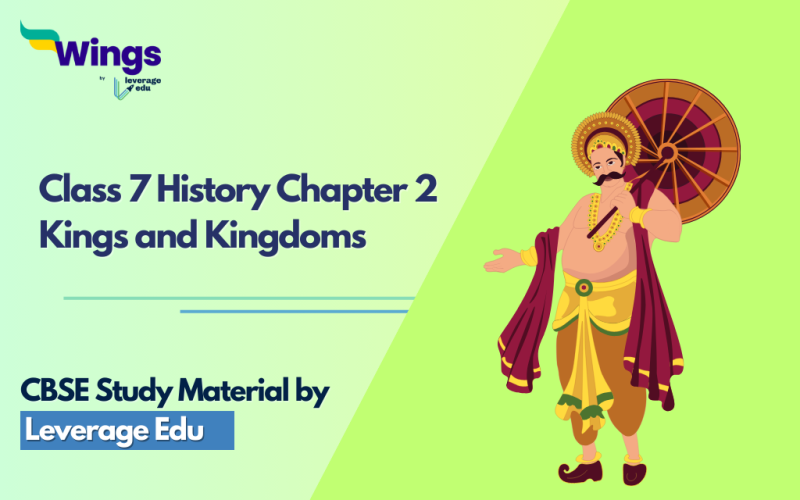NCERT Class 7 History Chapter 2 ‘Kings and Kingdoms’ is about the Chola Empire and its Emperors. To explore the key details of the 13th century Chola Empire check out the Summary section of the notes. Also, get answers to important questions and answers in the chapter helpful for your tests and examinations. Besides, you can download NCERT Solutions for the chapter ‘Kings and Kingdoms’. Let us proceed with this History lesson!!
Download Social Science Class 7 History Chapter 2 Important Questions and Answers PDF
Table of Contents
Check out Ashoka: The Great Ruler of the Mauryan Empire
Explore Notes of Class 7 History Chapters Here
Kings and Kingdoms Class 7 Notes
Let us now look at the summary of Class 7 History Chapter 2.
Summary: NCERT Class 7 History Chapter 2
In NCERT Class 7 History Chapter 2 Kings and Kingdoms, we study the rich history of the Chola dynasty, a powerful empire that thrived in South India. The Cholas were known for their exceptional governance, and remarkable achievements in art, architecture, and maritime trade. They ruled from the 9th to the 13th century, leaving an indelible mark on Indian history. The Chola dynasty’s capital was Tanjore, where they built grand temples like the Brihadeshwara Temple, showcasing their architectural prowess. They also established a strong administrative system, emphasizing local self-governance. The chapter also highlights the social structure of Chola society, comprising kings, nobles, farmers, and artisans.
Download Social Science Class 7 History Chapter 2 Important Questions and Answers PDF
Download NCERT Solutions of Class 7 History Chapters Here
Important Questions and Answers in NCERT Class 7 History Chapter 2
1. Match the following:
Gurjara-Pratiharas Western Deccan
Rashtrakutas Bengal
Palas Gujarat and Rajasthan
Cholas Tamil Nadu
Ans:
Gurjara-Pratiharas- Gujarat and Rajasthan
Rashtrakutas- Western Deccan
Palas- Bengal
Cholas- Tamil Nadu
2. Who were the parties involved in the “tripartite struggle”?
Ans: Rulers belonging to the Gurjara Pratihara, Rashtrakuta and Pala dynasties who fought for control over Kanauj were involved in the “tripartite struggle”.
3. What were the qualifications necessary to become a member of a committee of the sabha in the Chola empire?
Ans: The following qualifications were necessary for becoming a member of the sabha in the Chola empire:
- Must be owners of land from which land revenue is collected.
- Must have their own homes.
- Should be between 35 and 70 years of age.
- Should have knowledge of the Vedas.
- Should be well-versed in administrative matters and honest.
- If anyone has been a member of any committee in the last three years, he could not become a member of another committee.
- Anyone who has not submitted his accounts, and those of his relatives, could not contest the elections.
4. What were the two major cities under the control of the Chahamanas?
Ans: The two major cities that were under the control of the Chahamanas were Delhi and Ajmer.
5. How did the Rashtrakutas become powerful?
Ans: The Rashtrakutas in the Deccan were subordinate to the Chalukyas of Karnataka. During the mid-8th century, Dantidurga, a Rashtrakuta chief, overthrew his Chalukya overlord and performed a ritual called ‘Hiranya-garbha’ with the help of Brahmanas. During this period, it was thought that the sacrifice would be reborn as a Kshatriya, even if he was not one by birth. Also, they fought against the dynasties of Gurjara Pratihara and Palas. Thus, they successfully established kingdoms in Karnataka and Rajasthan respectively.
6. What did the new dynasties do to gain acceptance?
Ans: To gain acceptance, the new dynasties took on new titles and performed religious rituals to become a part of the Kshatriyas. They were known as subordinates or Samantas by their overloads and later declared themselves to be maha-Samanta after gaining power and wealth. The new dynasties also engaged themselves in warfare to assert their power and carve kingdoms for themselves.
7. What kind of irrigation works were developed in the Tamil region?
Ans: During the fifth or sixth century, the areas near the Kaveri River in Tamil Nadu were opened up for large-scale cultivation. The irrigation works that were developed in the Tamil region led to the development of water channels for agriculture, the construction of embankments to prevent floods, and the digging of wells and tanks for the storage of water.
8. What were the activities associated with Chola temples?
Ans: Chola temples were centers of craft production and often became the nuclei of settlements, which grew around them. The Chola temples were not only places of worship but also the hub of economic, social, and cultural life. They were also endowed with land by rulers, as well as by others. The produce of this land went into maintaining all the specialists who worked at the temple. Among the crafts associated with temples, the making of bronze images became the most distinctive and these bronze images are still considered the finest in the world. Most of these bronze images were of deities, while some of these images depicted devotees as well.
Check out Class 6 History Notes:
FAQs
Ans: Rulers belonging to the Gurjara Pratihara, Rashtrakuta, and Pala dynasties who fought for control over Kanauj were involved in the “tripartite struggle”.
Ans: The two major cities that were under the control of the Chahamanas were Delhi and Ajmer.
Ans: During the fifth or sixth century, the areas near the Kaveri River in Tamil Nadu were opened up for large-scale cultivation. The irrigation works that were developed in the Tamil region led to the development of water channels for agriculture, the construction of embankments to prevent floods, and the digging of wells and tanks for the storage of water.
Follow Leverage Edu for complete study material on CBSE Notes of Class 7 History
 One app for all your study abroad needs
One app for all your study abroad needs













